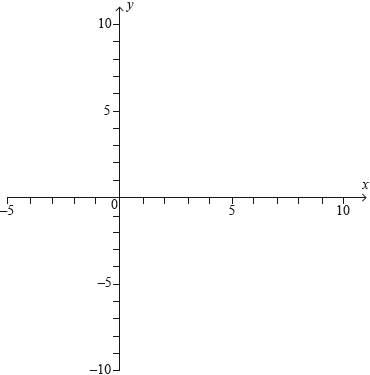| Date | May 2022 | Marks available | 2 | Reference code | 22M.2.AHL.TZ1.10 |
| Level | Additional Higher Level | Paper | Paper 2 | Time zone | Time zone 1 |
| Command term | Sketch | Question number | 10 | Adapted from | N/A |
Question
Consider the function , where .
The curve is rotated about the -axis to form a solid of revolution that is used to model a water container.
At , the container is empty. Water is then added to the container at a constant rate of .
Sketch the curve , clearly indicating the coordinates of the endpoints.
Show that the inverse function of is given by .
State the domain and range of .
Show that the volume, , of water in the container when it is filled to a height of metres is given by .
Hence, determine the maximum volume of the container.
Find the time it takes to fill the container to its maximum volume.
Find the rate of change of the height of the water when the container is filled to half its maximum volume.
Markscheme
correct shape (concave down) within the given domain A1
and A1
Note: The coordinates of endpoints may be seen on the graph or marked on the axes.
[2 marks]
interchanging and (seen anywhere) M1
A1
A1
AG
[3 marks]
OR domain A1
OR OR range A1
[2 marks]
attempt to substitute into the correct volume formula (M1)
A1
A1
AG
Note: Award marks as appropriate for correct work using a different variable e.g.
[3 marks]
attempt to substitute into (M1)
A1
[2 marks]
time (M1)
A1
[2 marks]
attempt to find the height of the tank when (M1)
(A1)
attempt to use the chain rule or differentiate with respect to (M1)
OR (A1)
attempt to substitute their and (M1)
A1
[6 marks]
Examiners report
Part a) was generally well done, with the most common errors being to use an incorrect domain or not to give the coordinates of the endpoints. Some graphs appeared to be straight lines; some candidates drew sketches which were too small which made it more difficult for them to show the curvature.
Most candidates were able to show the steps to find an inverse function in part b), although occasionally a candidate did not explicitly swop the x and y variables before writing down the inverse function, which was given in the question. Many candidates struggled to identify the domain and range of the inverse, despite having a correct graph.
Part c) required a rotation around the y-axis, but a number of candidates attempted to rotate around the x-axis or failed to include limits. In the same vein, many substituted 2 into the formula instead of the square root of 3 when answering the second part. Many subsequently gained follow through marks on part d).
There were a number of good attempts at related rates in part e), with the majority differentiating V with respect to t, using implicit differentiation. However, many did not find the value of h which corresponded to halving the volume, and a number did not differentiate with respect to t, only with respect to h.


